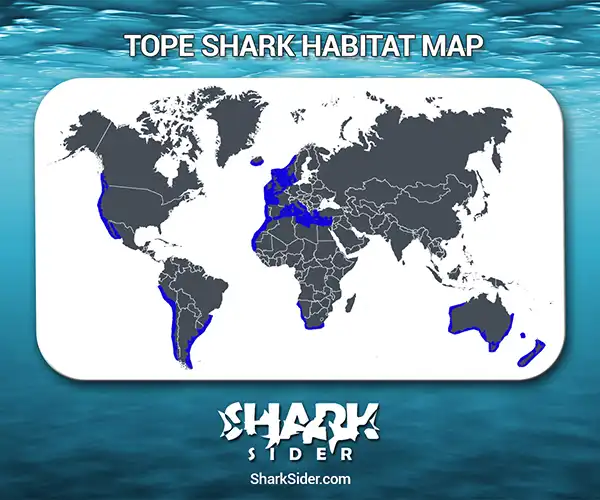The tope shark is a deep sea dwelling, migratory shark found worldwide. It is the only member of the genus Galeorhinus, belonging to the hound sharks of the Triakidae family. They are also known as school sharks, snapper sharks, liver-oil sharks, and soupfin sharks.
Tope Shark Scientific Classification |
|
| Kingdom | Animalia |
| Phylum | Chordata |
| Class | Chondrichthyes |
| Order | Carcharhiniformes |
| Family | Triakidae |
| Genus | Galeorhinus |
| Scientific Name | Galeorhinus galeus |
Description
Male tope sharks reach maturity at the age of 12-17 and when they are about 5 feet in length. Females take 13-15 years to hit adulthood and reach maturity when their body length is about 5.8 feet. The males grow to about 6.3 feet in total length, while females can reach up to 6.4 feet.
The biggest recorded tope shark weighed about 98.5 pounds.
The shark has a long, slender body with a dark blue-grayish upper body and a white ventral under-belly.
Their head consists of a long, pointed snout and a large crescent-shaped mouth with small blade-like teeth.
The second dorsal fins are located just above the anal fins and are about the same size. A notch present at the terminal lobe of the caudal fin is about the same size as the rest of the fin. Juvenile sharks smaller than 2 feet have black spots in their dorsal and caudal fins, and their pectoral fins consist of a white trailing edge.
Where do they live
Map Of The Tope Shark’s Habitat

Tope sharks are a widely distributed species.
They are found in the western Atlantic (southern Brazil – Argentina), eastern Atlantic (Iceland – South Africa), the Mediterranean, western Indian Ocean, South Africa, the southwest Pacific (Australia – New Zealand), central Pacific (Hawaii), the southeast Pacific(Chile and Peru), the eastern Pacific (British Columbia – southern California) and the Gulf of California in Mexico’s northwestern coast.
Tope sharks are usually found in temperate waters and continental shelves. They can also be found on coastal shorelines, bays, rocky reefs, and submarine canyons. They prefer muddy depths of 1,350-2600 feet. While males live deeper, females are usually seen at less than 180 feet.
The females give birth in sheltered bays and estuaries. The juvenile sharks remain in these areas for two years and grow while the adult sharks ward off into deeper waters.
Behavior
Dietary
These sharks have no particular diet preference and feed on whatever is plenty and easily available. This information was concluded from examining the stomach contents of the shark caught in California.
Their diet primarily consists of fish such as sardines, midshipmen, flatfish, rockfish, and salmon. Invertebrate prey items of the tope shark include squid, octopus, crabs, marine snails, worms, and sea urchins. They also feed on other small sharks and stingrays.
They hunt and feed both in open water and near the seabed.
Migratory
These sharks are highly migratory, occur in small schools, and cover long distances.
They tend to move northward during the summer and back towards the equator in the winter.
The migratory routes of these sharks may be disrupted by the magnetic fields caused by current flow and deep-sea power cables.
Reproductory
The ovulation period occurs during summer, while mating takes place during the months of spring. This shark species is ovoviviparous (fertilized eggs develop in females) without a yolk-sac placenta. The gestation period of tope sharks lasts for almost a year.
Around 6-52 pups are born in a litter. This number varies according to the size of the mother.
Juveniles measure about 12-14 inches at birth.
Female tope sharks can store sperm long after mating, resulting in pups from the same litter having different parents.
It has been implied that the tope shark can live up to 55 years.
Adaptations
Their slender body makes them strong and fast swimmers capable of traveling 35 miles in a single day.
Some tope sharks tagged in the UK and southern California have been found as far away as the Canary Islands and British Columbia, respectively.
They have been known to travel 750 miles along the coast of Australia and have turned up in New Zealand.
Interactions with humans
Due to their small size, tope sharks are not considered dangerous. There have been no reports of attacks on humans.
They are a popular game hunted commercially and captured for their meat, liver oil (which is high in vitamin A), and fins. The Asian market has a high demand for this shark’s fin for making shark fin soup, earning it its name – soupfin shark.
The excessive killing of these species has brought about a rapid decline in their population. In its Red List of Threatened species, tope sharks have been classified as critically endangered by the IUCN. Wildlife Trusts must collaborate with fishermen, researchers, politicians, and local people to conserve this species so their numbers can stabilize.
